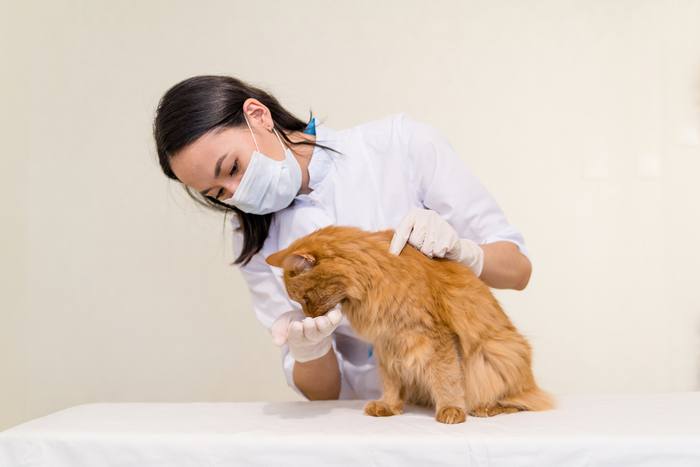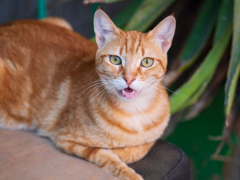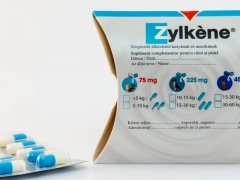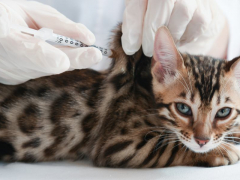
Zonisamide, which may also be known by the brand name Zonegran, is an anticonvulsant drug that may be used in some cats who are experiencing seizure disorders. In this article, you’ll learn how zonisamide works, what situations it may be used in, side effects to look for in cats, and some frequently asked questions.
Zonisamide for Cats Overview

About Zonisamide in Cats

Zonisamide has been studied much more in dogs than in cats, and it is not typically thought of as a first-line choice anticonvulsant for kitties.
Zonisamide is an anti-seizure medication used in veterinary medicine for cats in a variety of cases where a seizure disorder of some kind is present.
A seizure occurs when a sudden discharge of electrical signals occurs in the brain that leads to involuntary activity of the body, or seizing.
Patients experiencing a seizure often lose consciousness and the body may then exhibit appearance of muscle spasms, convulsions, or a pet may go completely rigid with stiff muscles. Drooling, urination, and defecation may also occur.
Seizures can occur for a variety of reasons. The presence of brain tumors and inflammatory lesions in the brain can be one set of causes where something structurally abnormal is present. Pets may also develop seizures from certain underlying medical disorders like liver and kidney disease, toxin ingestion, or if a diabetic cat’s blood sugar goes too low.
But seizures can also occur secondary to a condition known as idiopathic epilepsy. With epilepsy, the neurologic overexcitement occurs leading to a seizure, but there is no known cause. Pets with epilepsy often have normal MRI (magnetic resonance imaging) scans of the brain.
As an anticonvulsant medication, zonisamide helps to decrease the chance of a seizure occurring and reduce seizure frequency by reducing the abnormal electrical activity that leads to seizure episodes. There are several types of anti-seizure medications available, each working in a different way and with some being more effective in some cases than others.
What Does Zonisamide Do for Cats?

It is helpful to note that unlike in dogs, where zonisamide is typically dosed every 12 hours, zonisamide for cats is usually only dosed once a day.
Zonisamide’s mechanism of action is not specifically known. However, it is thought that it works at sodium and calcium channels which can help to stabilize nerve cells and suppress the domino effect of electrical activity that leads to a seizure.
Zonisamide also affects certain neurotransmitters within the brain, namely supporting serotonin and dopamine (mood and pleasure hormones) though not affecting GABA (calming hormone). Zonisamide can also purportedly help to scavenge damage-causing free radicals within the brain.
Zonisamide has been studied much more in dogs than in cats, and it is not typically thought of as a first-line choice anticonvulsant for kitties. More common first-line choices may include phenobarbital or levetiracetam (Keppra).
More often, zonisamide may be turned to when a first-line anticonvulsant is not adequately controlling seizures, or if a cat experiences unacceptable side effects of another anticonvulsant, which leads to exploring other medication choices.
While there has not been a great deal of research on zonisamide use in cats as a single anticonvulsant choice, or monotherapy, there have certainly been anecdotal reports from individual cases where a cat has done well with it.
Zonisamide also tends to be a relatively inexpensive medication when dosed for a cat, which may also highlight it as a favorable choice in some cases.
Zonisamide is also typically only dosed once daily in cats, which may be a more favorable option compared to phenobarbital, which requires dosing every 12 hours, or Keppra, which most often requires dosing every eight hours.
Side Effects of Zonisamide for Cats

Side effects of zonisamide include loss of appetite, diarrhea, vomiting, balance issues, and sedation/drowsiness.
There can be a higher risk of side effects with zonisamide for cats.
In one study, about 50% of cats treated with zonisamide experienced adverse effects, which most often included loss of appetite, diarrhea, vomiting, balance issues when walking (ataxia), and sedation/drowsiness (somnolence).
In another review of case reports, a majority of cats did not appear to have side effects on zonisamide. However, the efficacy or benefits of the medication as well as the safety profile as a lone treatment was considered weak.
Zonisamide is considered to be a teratogen, meaning that it can lead to birth defects if used in pregnant patients. This has not been documented specifically in cats, but has been found to be the case in mice, rats, dogs, and humans.
For this reason, it is recommended to administer any oral zonisamide medication to your cat using disposable gloves.
Because zonisamide is largely metabolized by the liver and excreted by the kidneys, it should be used cautiously in pets that have any pre-existing liver or kidney disease.
If you are ever concerned that your kitty may have developed side effects while using zonisamide, or if an overdose is suspected, contact your veterinarian, the ASPCA Animal Poison Control Center (1-888-426-4435), or Pet Poison Helpline (1-855-764-7661) immediately for further advice.
Zonisamide for Cats Dosage

It is advised that pet owners wear disposable gloves when administering zonisamide.
The dosage for zonisamide for cats has a great deal of variation. A veterinarian may make dose adjustments depending on whether it is being used alone or in conjunction with another medication. It may also be started out at a lower dosage to observe how a kitty tolerates it before increasing the dose further.
Because of these variations and precautions, it is best for an attending veterinarian to determine the proper oral administration dosage for zonisamide for cats and for these reasons, a specific dose is not provided.
It is helpful to note that unlike in dogs, where zonisamide is typically dosed every 12 hours, zonisamide for cats is usually only dosed once a day.
Although adverse effects are certainly possible with zonisamide, it is important to not stop the medication abruptly, especially if your cat has been on it for any length of time. Always speak first with your vet.
Stopping any anticonvulsant medication abruptly can lead to rebound seizures occurring.
Zonisamide is unlikely to have any drug interactions with other commonly prescribed medications. However, most notably, the dosage may need adjustment if a kitty is also on phenobarbital for seizures.
Conclusion

Zonisamide is a medication commonly used to aid in addressing seizure disorders in pets. In cats, it may be considered more as a back-up or add-on therapy for seizures versus a primary first-line choice.
The risk of adverse effects may be higher in cats, and so a cat’s tolerance to the medication may be an important factor in determining whether or not to use it as a treatment choice.
Drug Dosing Disclaimer: We are only able to provide doses for medications that are FDA approved for use in cats and only as the label guidelines dictate. For medications that are used off-label we can only provide guidelines and safety information for use. Safe and appropriate dosing for off-label medications can only be determined by a primary care veterinarian.
We encourage you to work with your veterinarian to determine if a particular medication is appropriate for your cat. Changing or adjusting a dose for your cat on your own without consulting with a veterinarian can carry risk. We do not encourage use of medications prescribed for human use in pets without first consulting with a primary care veterinarian.
Frequently Asked Questions
Is zonisamide safe for cats?
All medications can carry with them a risk of side effects, though zonisamide may have a higher rate in kitties. According to one study, about 50% of cats experienced adverse effects including poor appetite, vomiting, diarrhea, and drowsiness. Zonisamide may also not be an advisable choice in cats with pre-existing liver or kidney disease.
In cats without pre-existing liver or kidney disease who appear to tolerate the medication well, it could otherwise be considered a safe medication to continue, especially if it is helping to manage a seizure disorder.
How long does it take for zonisamide to work in cats?
In cats, zonisamide has an onset of action of about four hours. Like many anticonvulsant medications, a certain period of time of doses may be required to reach a “steady state” where drug levels are consistently high enough to prevent seizures.
Any time a patient is actively convulsing for more than three minutes, immediate veterinary care should be sought. Also, never try to orally administer an anticonvulsant medication while a pet is actively seizing, as this greatly increases the risk for a bite injury to the person trying to give the medication, is unlikely to be properly swallowed by the patient, and could present a choking hazard.
What is the side effects of zonisamide?
Zonisamide can have several adverse effects, including a drop in appetite, vomiting, diarrhea, balance issues when walking (which is termed ataxia), and somnolence (excessive drowsiness).
In some studies these effects have been seen in about 50% of cats, while in other studies the percentages have been found to be lower.
What type of seizures does zonisamide treat?
Zonisamide is most often used in pets as an add-on therapy for treatment of epilepsy. Epileptic seizures are ones that occur from an overexcitement of electrical activity within the brain. In idiopathic epilepsy, there is no known cause, though sometimes outside triggers, like stress or loud noises, may be connected.
Seizures may also be caused by a lesion within the brain, like a tumor or inflammatory mass. A previous trauma that led to damage of brain tissue may also contribute to a seizure disorder.
Like all anticonvulsants, zonisamide may be used in any of these cases where seizures are occurring, as a way of reducing their likelihood to occur by quieting the electrical overactivity within the brain by different mechanisms.
However, different anticonvulsants have different mechanisms of action and different degrees of efficacy. While zonisamide may be used in the case of any seizure disorder, it is most often used in cats as an add-on or secondary choice to help with seizure control.







